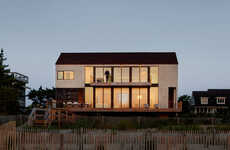
The Cedar Park House Features Water-Collecting Roofs
Vasiliki Marapas — October 10, 2014 — Art & Design
References: petercohanarchitect & contemporist
Architect Peter Cohan was responsible for the 'Cedar Park House,' located in Seattle, Washington.
Exposure to water threatens to derail the home from its precarious position on a slope, meaning the architect had to come up with an energy-efficient way of collecting water before it can do any damage to the foundation. This was done through the use of a water-collecting roof and cast-concrete walls.
The walls are a defining aspect, as they delineate the interior and exterior and set up the spatial arrangement of the home. More importantly, the Y-shape that the walls create forms a datum against which the site's slope is calibrated. Meanwhile, the water-collecting roof prevents landslides and erosion that can occur on the sloping site, (especially if it becomes water-logged). The roofs have different methods of carrying out their function, with the western roof relocating the water to be drained at street-level, and the eastern roof collecting water in a gable, and then, cistern.
Exposure to water threatens to derail the home from its precarious position on a slope, meaning the architect had to come up with an energy-efficient way of collecting water before it can do any damage to the foundation. This was done through the use of a water-collecting roof and cast-concrete walls.
The walls are a defining aspect, as they delineate the interior and exterior and set up the spatial arrangement of the home. More importantly, the Y-shape that the walls create forms a datum against which the site's slope is calibrated. Meanwhile, the water-collecting roof prevents landslides and erosion that can occur on the sloping site, (especially if it becomes water-logged). The roofs have different methods of carrying out their function, with the western roof relocating the water to be drained at street-level, and the eastern roof collecting water in a gable, and then, cistern.
Trend Themes
1. Water-collecting Roofs - Innovative water-collecting roofs provide energy-efficient solutions for collecting water and preventing foundation damage.
2. Cast-concrete Walls - Cast-concrete walls define the interior and exterior of a structure while acting as a barrier against sloping site challenges.
3. Spatial Arrangement - The spatial arrangement of a home is optimized through the use of Y-shaped walls that calibrate the site's slope.
Industry Implications
1. Architecture - The architecture industry can leverage the use of water-collecting roofs and cast-concrete walls for sustainable and resilient building designs.
2. Construction - In the construction industry, incorporating innovative water management systems and spatial arrangement techniques can enhance the durability and stability of structures built on slopes.
3. Environmental Engineering - Environmental engineers can explore opportunities to develop advanced systems for managing water flow and erosion in sloping landscapes, contributing to sustainable development.
2.6
Score
Popularity
Activity
Freshness























